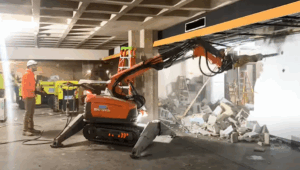In the UK, demolition robots have become a game-changer in the construction industry, particularly for soft strip demolition projects. Companies like Soft Strip Contractors are at the forefront of this technological advancement, employing state-of-the-art robotic systems to enhance efficiency and safety on-site.
The Rise of Remote-Controlled Demolition Robots
Traditional demolition methods often involve manual labor and heavy machinery, which can be hazardous and time-consuming. Remote-controlled demolition robots, such as the Brokk and Husqvarna DXR series, offer a safer and more efficient alternative. These compact machines can be operated from a distance, allowing workers to remain at a safe location while the robot performs tasks like breaking concrete, removing fixtures, and dismantling non-structural elements.
Advantages in Soft Strip Demolition
Soft strip demolition involves the careful removal of non-structural elements from a building, such as partitions, ceilings, and fixtures, in preparation for refurbishment or full demolition. Demolition robots excel in this area due to their precision and versatility. They can access confined spaces, navigate through standard doorways, and operate in environments with limited ventilation. Additionally, their electric-powered systems produce minimal noise and vibrations, reducing disruption to surrounding areas and ensuring compliance with environmental regulations.
Looking Ahead: The Path to Full Autonomy
While current demolition robots are operated remotely, the future holds the potential for fully autonomous machines. Advancements in artificial intelligence, machine learning, and robotics are paving the way for robots that can perform soft strip demolition tasks with minimal human intervention. These autonomous systems could analyze structural layouts, identify materials for recycling, and execute demolition plans with precision, further enhancing safety and efficiency.
Demolition robots are transforming the landscape of soft strip demolition in the UK. Their ability to operate remotely ensures worker safety, while their precision and versatility improve efficiency and reduce environmental impact. As technology continues to evolve, the prospect of fully autonomous demolition robots becomes increasingly feasible, promising even greater advancements in the industry.
🏗️ FAQ: Demolition Robots in Soft Strip Demolition (UK)
1. What is a demolition robot?
A demolition robot is a compact, remote-controlled machine designed to carry out demolition tasks such as breaking concrete, removing fixtures, and dismantling building interiors.
2. What is soft strip demolition?
Soft strip demolition involves the removal of non-structural elements from buildings (e.g., ceilings, partitions, fixtures) before refurbishment or full structural demolition.
3. How do demolition robots improve safety?
They allow operators to control the machine remotely, keeping workers out of hazardous zones and reducing the risk of injury from falling debris, dust, or machine-related accidents.
4. Which demolition robots are commonly used in the UK?
Popular models include the Brokk and Husqvarna DXR series, both known for their strength, precision, and compact design.
5. Can these robots fit inside standard buildings?
Yes, most demolition robots are designed to fit through standard doorways and operate in confined or hard-to-reach areas.
6. Are demolition robots suitable for indoor use?
Yes. Their electric-powered motors produce low emissions, making them ideal for indoor environments with limited ventilation.
7. Do demolition robots make a lot of noise or vibration?
No. Compared to traditional equipment, they generate minimal noise and vibration, reducing disruption to surrounding areas.
8. How are demolition robots controlled?
Currently, they are remote-controlled by trained operators who guide the machine from a safe distance using handheld devices.
9. What tasks can demolition robots perform during soft strip work?
They can remove walls, ceilings, tiles, ductwork, electrical systems, and other interior components with precision.
10. Are demolition robots environmentally friendly?
Yes. Their electric operation and reduced noise/vibration help meet environmental and urban compliance standards.
11. Can demolition robots operate autonomously?
Not yet fully, but research into AI and machine learning is underway to develop autonomous demolition robots in the near future.
12. What are the limitations of demolition robots?
They may struggle with very large structural elements or need human assistance for highly complex or delicate removals.
13. Who are the leading providers of robotic demolition services in the UK?
Companies like Soft Strip Contractors are pioneering robotic demolition by integrating cutting-edge tech with skilled teams.
14. Is special training required to operate a demolition robot?
Yes. Operators must undergo specific training and certification to handle remote-control demolition equipment safely and effectively.
15. How is the future of demolition robotics shaping up?
Advancements in robotics, AI, and sensors point toward a future where fully autonomous robots can analyze structures, sort materials for recycling, and carry out demolitions with minimal human input.
More Stories
Navigating the Promise and Perils of Biotechnology
Biotechnology stands at the forefront of scientific innovation, offering transformative solutions to some of humanity's most pressing challenges while simultaneously...
The Promise of Future Technologies: Shortening the Working Week and Enhancing Quality of Life
In the landscape of rapidly evolving technology, the prospect of a shorter working week and improved quality of life is...
Exploring the Impact of Future Technologies on Humanity
As we stand on the cusp of a new era defined by rapid technological advancement, the possibilities and implications of...
Skynet Unleashed: The Evolution of Artificial Intelligence in Military Operations
The concept of Skynet, as portrayed in the Terminator franchise, represents a dystopian vision of artificial intelligence (AI) gone awry,...
Exploring the Justifications Behind Robophobia
In the rapidly advancing landscape of artificial intelligence and robotics, the concept of robophobia—fear or aversion towards robots and automation—has...
Understanding Live Language Models: A Comprehensive Exploration
Live language models represent a significant advancement in artificial intelligence (AI) technology, revolutionizing the way humans interact with and utilize...

